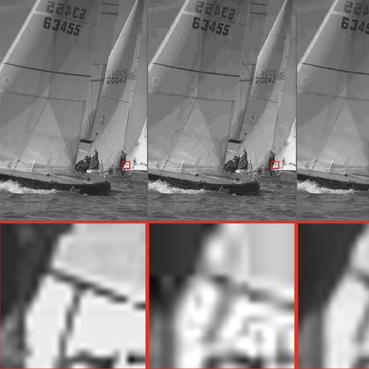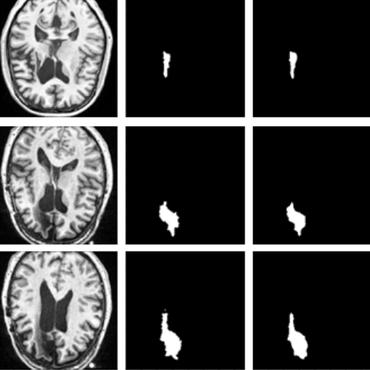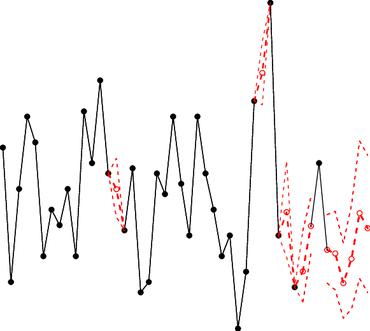Search Results for author: Jerry L. Prince
Found 46 papers, 8 papers with code
Revisiting registration-based synthesis: A focus on unsupervised MR image synthesis
no code implementations • 19 Feb 2024 • Savannah P. Hays, Lianrui Zuo, Yihao Liu, Anqi Feng, Jiachen Zhuo, Jerry L. Prince, Aaron Carass
Subsequently, this estimated deformation is applied to align the paired WMn counterpart of the moving CSFn image, yielding a synthetic WMn image for the fixed CSFn image.
Speech motion anomaly detection via cross-modal translation of 4D motion fields from tagged MRI
no code implementations • 10 Feb 2024 • Xiaofeng Liu, Fangxu Xing, Jiachen Zhuo, Maureen Stone, Jerry L. Prince, Georges El Fakhri, Jonghye Woo
In this work, we aim to develop a framework for detecting speech motion anomalies in conjunction with their corresponding speech acoustics.
Is Registering Raw Tagged-MR Enough for Strain Estimation in the Era of Deep Learning?
no code implementations • 31 Jan 2024 • Zhangxing Bian, Ahmed Alshareef, Shuwen Wei, Junyu Chen, Yuli Wang, Jonghye Woo, Dzung L. Pham, Jiachen Zhuo, Aaron Carass, Jerry L. Prince
This is a factor that has been overlooked in prior research on tMRI post-processing.
Super-Resolution Multi-Contrast Unbiased Eye Atlases With Deep Probabilistic Refinement
no code implementations • 5 Jan 2024 • Ho Hin Lee, Adam M. Saunders, Michael E. Kim, Samuel W. Remedios, Yucheng Tang, Qi Yang, Xin Yu, Shunxing Bao, Chloe Cho, Louise A. Mawn, Tonia S. Rex, Kevin L. Schey, Blake E. Dewey, Jeffrey M. Spraggins, Jerry L. Prince, Yuankai Huo, Bennett A. Landman
These variations limit the feasibility and robustness of generalizing population-wise features of eye organs to an unbiased spatial reference.
AniRes2D: Anisotropic Residual-enhanced Diffusion for 2D MR Super-Resolution
no code implementations • 7 Dec 2023 • Zejun Wu, Samuel W. Remedios, Blake E. Dewey, Aaron Carass, Jerry L. Prince
Our findings contribute valuable insights to the application of DDPMs for SR of anisotropic MR images.
Towards an accurate and generalizable multiple sclerosis lesion segmentation model using self-ensembled lesion fusion
no code implementations • 3 Dec 2023 • Jinwei Zhang, Lianrui Zuo, Blake E. Dewey, Samuel W. Remedios, Dzung L. Pham, Aaron Carass, Jerry L. Prince
Automatic multiple sclerosis (MS) lesion segmentation using multi-contrast magnetic resonance (MR) images provides improved efficiency and reproducibility compared to manual delineation.
Harmonization-enriched domain adaptation with light fine-tuning for multiple sclerosis lesion segmentation
no code implementations • 31 Oct 2023 • Jinwei Zhang, Lianrui Zuo, Blake E. Dewey, Samuel W. Remedios, Savannah P. Hays, Dzung L. Pham, Jerry L. Prince, Aaron Carass
Our experiments illustrate that the amalgamation of one-shot adaptation data with harmonized training data surpasses the performance of utilizing either data source in isolation.
Speech Audio Synthesis from Tagged MRI and Non-Negative Matrix Factorization via Plastic Transformer
no code implementations • 26 Sep 2023 • Xiaofeng Liu, Fangxu Xing, Maureen Stone, Jiachen Zhuo, Sidney Fels, Jerry L. Prince, Georges El Fakhri, Jonghye Woo
The tongue's intricate 3D structure, comprising localized functional units, plays a crucial role in the production of speech.
MomentaMorph: Unsupervised Spatial-Temporal Registration with Momenta, Shooting, and Correction
no code implementations • 5 Aug 2023 • Zhangxing Bian, Shuwen Wei, Yihao Liu, Junyu Chen, Jiachen Zhuo, Fangxu Xing, Jonghye Woo, Aaron Carass, Jerry L. Prince
We introduce a novel "momenta, shooting, and correction" framework for Lagrangian motion estimation in the presence of repetitive patterns and large motion.
A survey on deep learning in medical image registration: new technologies, uncertainty, evaluation metrics, and beyond
no code implementations • 28 Jul 2023 • Junyu Chen, Yihao Liu, Shuwen Wei, Zhangxing Bian, Shalini Subramanian, Aaron Carass, Jerry L. Prince, Yong Du
Deep learning technologies have dramatically reshaped the field of medical image registration over the past decade.
Attentive Continuous Generative Self-training for Unsupervised Domain Adaptive Medical Image Translation
no code implementations • 23 May 2023 • Xiaofeng Liu, Jerry L. Prince, Fangxu Xing, Jiachen Zhuo, Reese Timothy, Maureen Stone, Georges El Fakhri, Jonghye Woo
We evaluated our framework on two cross-scanner/center, inter-subject translation tasks, including tagged-to-cine magnetic resonance (MR) image translation and T1-weighted MR-to-fractional anisotropy translation.
Rapid Brain Meninges Surface Reconstruction with Layer Topology Guarantee
no code implementations • 13 Apr 2023 • Peiyu Duan, Yuan Xue, Shuo Han, Lianrui Zuo, Aaron Carass, Caitlyn Bernhard, Savannah Hays, Peter A. Calabresi, Susan M. Resnick, James S. Duncan, Jerry L. Prince
The meninges, located between the skull and brain, are composed of three membrane layers: the pia, the arachnoid, and the dura.
Optimal operating MR contrast for brain ventricle parcellation
no code implementations • 4 Apr 2023 • Savannah P. Hays, Lianrui Zuo, Yuli Wang, Mark G. Luciano, Aaron Carass, Jerry L. Prince
Development of MR harmonization has enabled different contrast MRIs to be synthesized while preserving the underlying anatomy.
DrDisco: Deep Registration for Distortion Correction of Diffusion MRI with single phase-encoding
no code implementations • 1 Apr 2023 • Zhangxing Bian, Muhan Shao, Aaron Carass, Jerry L. Prince
Since a great amount of diffusion data are only acquired with a single phase-encoding direction, the application of existing approaches is limited.
Label Propagation via Random Walk for Training Robust Thalamus Nuclei Parcellation Model from Noisy Annotations
no code implementations • 30 Mar 2023 • Anqi Feng, Yuan Xue, Yuli Wang, Chang Yan, Zhangxing Bian, Muhan Shao, Jiachen Zhuo, Rao P. Gullapalli, Aaron Carass, Jerry L. Prince
Data-driven thalamic nuclei parcellation depends on high-quality manual annotations.
Automated Ventricle Parcellation and Evan's Ratio Computation in Pre- and Post-Surgical Ventriculomegaly
no code implementations • 3 Mar 2023 • Yuli Wang, Anqi Feng, Yuan Xue, Lianrui Zuo, Yihao Liu, Ari M. Blitz, Mark G. Luciano, Aaron Carass, Jerry L. Prince
Normal pressure hydrocephalus~(NPH) is a brain disorder associated with enlarged ventricles and multiple cognitive and motor symptoms.
FastCod: Fast Brain Connectivity in Diffusion Imaging
no code implementations • 18 Feb 2023 • Zhangxing Bian, Muhan Shao, Jiachen Zhuo, Rao P. Gullapalli, Aaron Carass, Jerry L. Prince
Connectivity information derived from diffusion-weighted magnetic resonance images~(DW-MRIs) plays an important role in studying human subcortical gray matter structures.
Synthesizing audio from tongue motion during speech using tagged MRI via transformer
no code implementations • 14 Feb 2023 • Xiaofeng Liu, Fangxu Xing, Jerry L. Prince, Maureen Stone, Georges El Fakhri, Jonghye Woo
However, elucidating the relationship between these two sources of information is challenging, due in part to the disparity in data structure between spatiotemporal motion fields (i. e., 4D motion fields) and one-dimensional audio waveforms.
New starting point registration method for tagged MRI tongue motion estimation
no code implementations • 8 Feb 2023 • Jinglun Yu, Muhan Shao, Zhangxing Bian, Xiao Liang, Jiachen Zhuo, Maureen Stone, Jerry L. Prince
Accurate tongue motion estimation is essential for tongue function evaluation.
A latent space for unsupervised MR image quality control via artifact assessment
no code implementations • 1 Feb 2023 • Lianrui Zuo, Yuan Xue, Blake E. Dewey, Yihao Liu, Jerry L. Prince, Aaron Carass
Image quality control (IQC) can be used in automated magnetic resonance (MR) image analysis to exclude erroneous results caused by poorly acquired or artifact-laden images.
DRIMET: Deep Registration for 3D Incompressible Motion Estimation in Tagged-MRI with Application to the Tongue
1 code implementation • 18 Jan 2023 • Zhangxing Bian, Fangxu Xing, Jinglun Yu, Muhan Shao, Yihao Liu, Aaron Carass, Jiachen Zhuo, Jonghye Woo, Jerry L. Prince
We show that the method outperforms existing approaches, and also exhibits improvements in speed, robustness to tag fading, and large tongue motion.
Segmenting thalamic nuclei from manifold projections of multi-contrast MRI
no code implementations • 15 Jan 2023 • Chang Yan, Muhan Shao, Zhangxing Bian, Anqi Feng, Yuan Xue, Jiachen Zhuo, Rao P. Gullapalli, Aaron Carass, Jerry L. Prince
After registration of these contrasts and isolation of the thalamus, we use the uniform manifold approximation and projection (UMAP) method for dimensionality reduction to produce a low-dimensional representation of the data within the thalamus.
HACA3: A Unified Approach for Multi-site MR Image Harmonization
no code implementations • 12 Dec 2022 • Lianrui Zuo, Yihao Liu, Yuan Xue, Blake E. Dewey, Samuel W. Remedios, Savannah P. Hays, Murat Bilgel, Ellen M. Mowry, Scott D. Newsome, Peter A. Calabresi, Susan M. Resnick, Jerry L. Prince, Aaron Carass
Furthermore, HACA3 is also robust to imaging artifacts and can be trained and applied to any set of MR contrasts.
Deep filter bank regression for super-resolution of anisotropic MR brain images
no code implementations • 6 Sep 2022 • Samuel W. Remedios, Shuo Han, Yuan Xue, Aaron Carass, Trac D. Tran, Dzung L. Pham, Jerry L. Prince
In 2D multi-slice magnetic resonance (MR) acquisition, the through-plane signals are typically of lower resolution than the in-plane signals.
Tagged-MRI Sequence to Audio Synthesis via Self Residual Attention Guided Heterogeneous Translator
no code implementations • 5 Jun 2022 • Xiaofeng Liu, Fangxu Xing, Jerry L. Prince, Jiachen Zhuo, Maureen Stone, Georges El Fakhri, Jonghye Woo
Understanding the underlying relationship between tongue and oropharyngeal muscle deformation seen in tagged-MRI and intelligible speech plays an important role in advancing speech motor control theories and treatment of speech related-disorders.
Disentangling A Single MR Modality
no code implementations • 10 May 2022 • Lianrui Zuo, Yihao Liu, Yuan Xue, Shuo Han, Murat Bilgel, Susan M. Resnick, Jerry L. Prince, Aaron Carass
Disentangling anatomical and contrast information from medical images has gained attention recently, demonstrating benefits for various image analysis tasks.
Coordinate Translator for Learning Deformable Medical Image Registration
1 code implementation • 5 Mar 2022 • Yihao Liu, Lianrui Zuo, Shuo Han, Yuan Xue, Jerry L. Prince, Aaron Carass
The majority of deep learning (DL) based deformable image registration methods use convolutional neural networks (CNNs) to estimate displacement fields from pairs of moving and fixed images.
Structure-aware Unsupervised Tagged-to-Cine MRI Synthesis with Self Disentanglement
no code implementations • 25 Feb 2022 • Xiaofeng Liu, Fangxu Xing, Jerry L. Prince, Maureen Stone, Georges El Fakhri, Jonghye Woo
Specifically, we propose a novel input-output image patches self-training scheme to achieve a disentanglement of underlying anatomical structures and imaging modalities.
Generative Self-training for Cross-domain Unsupervised Tagged-to-Cine MRI Synthesis
no code implementations • 23 Jun 2021 • Xiaofeng Liu, Fangxu Xing, Maureen Stone, Jiachen Zhuo, Reese Timothy, Jerry L. Prince, Georges El Fakhri, Jonghye Woo
Self-training based unsupervised domain adaptation (UDA) has shown great potential to address the problem of domain shift, when applying a trained deep learning model in a source domain to unlabeled target domains.
MR Slice Profile Estimation by Learning to Match Internal Patch Distributions
1 code implementation • 31 Mar 2021 • Shuo Han, Samuel Remedios, Aaron Carass, Michael Schär, Jerry L. Prince
To super-resolve the through-plane direction of a multi-slice 2D magnetic resonance (MR) image, its slice selection profile can be used as the degeneration model from high resolution (HR) to low resolution (LR) to create paired data when training a supervised algorithm.
Information-based Disentangled Representation Learning for Unsupervised MR Harmonization
no code implementations • 24 Mar 2021 • Lianrui Zuo, Blake E. Dewey, Aaron Carass, Yihao Liu, Yufan He, Peter A. Calabresi, Jerry L. Prince
Accuracy and consistency are two key factors in computer-assisted magnetic resonance (MR) image analysis.
A Structural Causal Model for MR Images of Multiple Sclerosis
1 code implementation • 4 Mar 2021 • Jacob C. Reinhold, Aaron Carass, Jerry L. Prince
Precision medicine involves answering counterfactual questions such as "Would this patient respond better to treatment A or treatment B?"
Dual-cycle Constrained Bijective VAE-GAN For Tagged-to-Cine Magnetic Resonance Image Synthesis
no code implementations • 14 Jan 2021 • Xiaofeng Liu, Fangxu Xing, Jerry L. Prince, Aaron Carass, Maureen Stone, Georges El Fakhri, Jonghye Woo
Tagged magnetic resonance imaging (MRI) is a widely used imaging technique for measuring tissue deformation in moving organs.
A review of deep learning in medical imaging: Imaging traits, technology trends, case studies with progress highlights, and future promises
no code implementations • 2 Aug 2020 • S. Kevin Zhou, Hayit Greenspan, Christos Davatzikos, James S. Duncan, Bram van Ginneken, Anant Madabhushi, Jerry L. Prince, Daniel Rueckert, Ronald M. Summers
In this survey paper, we first present traits of medical imaging, highlight both clinical needs and technical challenges in medical imaging, and describe how emerging trends in deep learning are addressing these issues.
A Deep Joint Sparse Non-negative Matrix Factorization Framework for Identifying the Common and Subject-specific Functional Units of Tongue Motion During Speech
no code implementations • 9 Jul 2020 • Jonghye Woo, Fangxu Xing, Jerry L. Prince, Maureen Stone, Arnold Gomez, Timothy G. Reese, Van J. Wedeen, Georges El Fakhri
Experiments carried out with in vivo tongue motion data show that the proposed method can determine the common and subject-specific functional units with increased interpretability and decreased size variability.
Self domain adapted network
1 code implementation • 7 Jul 2020 • Yufan He, Aaron Carass, Lianrui Zuo, Blake E. Dewey, Jerry L. Prince
However, training a model for each target domain is time consuming and computationally expensive, even infeasible when target domain data are scarce or source data are unavailable due to data privacy.
Finding novelty with uncertainty
2 code implementations • 11 Feb 2020 • Jacob C. Reinhold, Yufan He, Shizhong Han, Yunqiang Chen, Dashan Gao, Junghoon Lee, Jerry L. Prince, Aaron Carass
Medical images are often used to detect and characterize pathology and disease; however, automatically identifying and segmenting pathology in medical images is challenging because the appearance of pathology across diseases varies widely.
Validating uncertainty in medical image translation
1 code implementation • 11 Feb 2020 • Jacob C. Reinhold, Yufan He, Shizhong Han, Yunqiang Chen, Dashan Gao, Junghoon Lee, Jerry L. Prince, Aaron Carass
Medical images are increasingly used as input to deep neural networks to produce quantitative values that aid researchers and clinicians.
Evaluating the Impact of Intensity Normalization on MR Image Synthesis
1 code implementation • 11 Dec 2018 • Jacob C. Reinhold, Blake E. Dewey, Aaron Carass, Jerry L. Prince
Image synthesis learns a transformation from the intensity features of an input image to yield a different tissue contrast of the output image.
A Sparse Non-negative Matrix Factorization Framework for Identifying Functional Units of Tongue Behavior from MRI
no code implementations • 15 Apr 2018 • Jonghye Woo, Jerry L. Prince, Maureen Stone, Fangxu Xing, Arnold Gomez, Jordan R. Green, Christopher J. Hartnick, Thomas J. Brady, Timothy G. Reese, Van J. Wedeen, Georges El Fakhri
We then use three-dimensional synthetic and \textit{in vivo} tongue motion data using protrusion and simple speech tasks to identify subject-specific and data-driven functional units of the tongue in localized regions.
Cross-modality image synthesis from unpaired data using CycleGAN: Effects of gradient consistency loss and training data size
no code implementations • 18 Mar 2018 • Yuta Hiasa, Yoshito Otake, Masaki Takao, Takumi Matsuoka, Kazuma Takashima, Jerry L. Prince, Nobuhiko Sugano, Yoshinobu Sato
To evaluate image synthesis, we investigated dependency of image synthesis accuracy on 1) the number of training data and 2) the gradient consistency loss.
Topology guaranteed segmentation of the human retina from OCT using convolutional neural networks
no code implementations • 14 Mar 2018 • Yufan He, Aaron Carass, Bruno M. Jedynak, Sharon D. Solomon, Shiv Saidha, Peter A. Calabresi, Jerry L. Prince
Optical coherence tomography (OCT) is a noninvasive imaging modality which can be used to obtain depth images of the retina.
Self Super-Resolution for Magnetic Resonance Images using Deep Networks
no code implementations • 26 Feb 2018 • Can Zhao, Aaron Carass, Blake E. Dewey, Jerry L. Prince
This paper presents a self super-resolution~(SSR) algorithm, which does not use any external atlas images, yet can still resolve HR images only reliant on the acquired LR image.
Fiber Orientation Estimation Guided by a Deep Network
no code implementations • 19 May 2017 • Chuyang Ye, Jerry L. Prince
In this work we explore the use of a deep network for FO estimation in a dictionary-based framework and propose an algorithm named Fiber Orientation Reconstruction guided by a Deep Network (FORDN).
Speech Map: A Statistical Multimodal Atlas of 4D Tongue Motion During Speech from Tagged and Cine MR Images
no code implementations • 24 Jan 2017 • Jonghye Woo, Fangxu Xing, Maureen Stone, Jordan Green, Timothy G. Reese, Thomas J. Brady, Van J. Wedeen, Jerry L. Prince, Georges El Fakhri
Quantitative measurement of functional and anatomical traits of 4D tongue motion in the course of speech or other lingual behaviors remains a major challenge in scientific research and clinical applications.
Estimation of Fiber Orientations Using Neighborhood Information
no code implementations • 16 Jan 2016 • Chuyang Ye, Jiachen Zhuo, Rao P. Gullapalli, Jerry L. Prince
Data from diffusion magnetic resonance imaging (dMRI) can be used to reconstruct fiber tracts, for example, in muscle and white matter.













